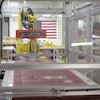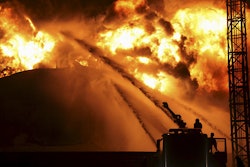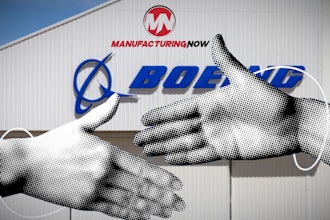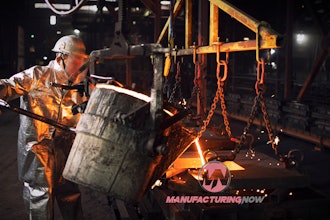
A Study in Machinery Failure Detection
By Joe Van Dyke, P.E.
This paper presents a comparison of
machinery condition monitoring
results obtained through the use of
troubleshooting tools and traditional
predictive maintenance instruments
and software.
The problem example
A critical motor‐driven fan develops a fan end
bearing defect that threatens to cause an
unplanned outage in a critical plant operating
process. Consider the following possible
scenarios:
• The maintenance department, in an effort to save money and time, only uses a troubleshooting
vibration test instrument on an ad hoc basis. They only check machines that are suspected of having
a problem. Because this fault mode develops fairly rapidly and with little warning, the machine
condition deteriorates over a matter of weeks or months going unnoticed until it is too late to plan
repairs and production must be interrupted.
• Or the maintenance team uses a troubleshooting instrument as more of a survey type instrument,
but they’ve learned not to use it on these machines because it keeps telling them the motor
bearings are bad on motors known to be in good condition. They are just as unaware of the
problem as in the first scenario.
• Or maybe they use their troubleshooter routinely on these machines which didn’t identify any faults
even the week before failure. This happens because the criteria are not specific to this type of
machine which has unique stiffness characteristics resulting in lower bearing wear indicating
amplitudes. There is no way to adjust the sensitivity even if it were known to be necessary.
All of these scenarios are realistic and represent the typical results one can expect when using a
troubleshooting vibration test instrument in place of a traditional predictive maintenance program. Also
consider that serious machine problems often can exist and be evident in vibration data, but not be
readily observable on site.
2
A better answer to the problem
A maintenance department implements traditional routine periodic monitoring using a portable survey
instrument and sophisticated analytical software or outsources the data analysis. This method is much
less susceptible to develop problems and will in all likelihood, have noticed the onset of the fan bearing
problem early enough to schedule the repairs at a convenient time, avoiding an unplanned outage
altogether.
Comparing and contrasting troubleshooting tools and traditional
systematic PdM
The similarities between troubleshooting and traditional surveying techniques are clear. Both
instruments and methods measure vibration and facilitate analysis of the recorded data. Both
approaches apply the same concept of accurately measuring machinery vibration, deriving some
indicative features from the data and comparing these features to relevant standards.
However, the reasons for better performance of traditional PdM methods and practices are perhaps not
so clear. They fall principally into two categories, technical and strategic.
Technical Advantage of traditional PdM
Traditional instruments and software offer users the ability to refine the test parameters and diagnostic
criteria as they conduct and accumulate more test results. This allows for adjustments to baselines and
other critical details to accommodate variability that exists among similar machine types. Different
applications, loading conditions, operating environments, and structural supports inherently result in
different vibration signatures. This capability is essential and available in traditional advanced analytical
software, but contrasts sharply with the limits that are implicit to troubleshooting instruments where
test parameters and diagnostic criteria applied are fixed or hard‐coded in what can be described asa
black box.
With a troubleshooting device, the user has little or no control over the analysis and may or may not be
able to view the recorded data once diagnostic results are derived.
Traditional test instruments and software offer a multitude of methods for fine‐tuning the analysis of
machinery vibration. The user of traditional software is operating a system that can learn and adapt
whereas the user of a troubleshooting instrument has the basic tools but no way to improve on it’s “out
of the box” performance.
Strategic Advantage of traditional PdM
Troubleshooting instruments are generally incapable of accomplishing the principal goal of predictive
maintenance, which is to efficiently and effectively provide information about the evolving condition of
critical plant machinery. One must trend the severity of specific faults over time to establish a rate of
degradation. In order to accomplish this, it is important that testing be conducted on a frequent and
regular basis.
3
Also, considering that typically less than ten percent of plant equipment may have developing problems,
it is extremely important to capture machine faults at an early stage. Reactive troubleshooting does not
accomplish this. With active PdM opposed to reactive troubleshooting, it is possible to detect signs that
a machine is going to fail weeks or months ahead of time. This allows maintenance actions to be
undertaken at times when it is convenient and will not interrupt the plant operation. While it is
possible to use a troubleshooting instrument as a survey instrument, the technical limitation of the
instrument and the accompanying software (if any) make prognostics (trending) very unreliable if not
impossible in most cases.
In an active Predictive Maintenance program, it is common practice to collect data routinely and
regularly, screening hundreds of machine tests of which only a few may indicate problems. The task of
analyzing the data accurately is the primary function of the program. The tools are optimized to
accomplish this routine cycle of test and analysis quickly and very accurately. Troubleshooting
instruments are simply not designed to perform this fundamental task in an efficient and effective
manner.
The troubleshooting instrument analyzes a machine. But the question is if you have not been screening
on a periodic basis, how do you know when to test and analyze? Also, if not screened on a routine basis,
typically the fault is going to have to be at an advanced enough state that it’s already been detected by
operators ears, eyes or smells of something burning... so there is less time to take action to avoid loss or
some level of reduced production.
While taking corrective action before a failure reduces cost of machine repairs, the real money saved is
by avoiding a production interruption. This can only be achieved by applying a Predictive Maintenance
program that includes periodic monitoring of machines, identifying faults at an early stage and planning
and prioritizing repairs during a planned outage or period that is convenient to the plant.
The Ultimate question
Troubleshooting instruments and methods and traditional PdM instruments/software have similarities,
but their effectiveness as maintenance tools are vastly different. Ultimately you must ask: Do you want
to test a few suspect machines and identify a limited set of problems with pretty good accuracy, or do
you want to survey a large number of machines for the maximum set of faults with highest achievable
accuracy to optimize the maintenance in your plant?
© 2011 – Azima DLI – All rights reserved.
About the author:
Joe Van Dyke, Vice President, Operations & Business Development
During Joe Van Dyke's career at DLI Engineering, he managed commercial and government engineering
activities and was a member of the company's senior management team. Joe is the original designer and
developer of the automated diagnostic system software that is contained in the ExpertALERT predictive
maintenance systems. Joe is a recipient of the US Department of the Navy’s Reliability, Maintainability and
Quality Assurance Award in recognition of the contribution to the overall fleet readiness made possible
through the development and deployment of Azima DLI’s ExpertALERT software. Joe holds a master's of
science degree in mechanical engineering from the University of Washington and is a licensed mechanical
engineer for the State of Washington. He is the author of several papers on the subject of automated
diagnostic techniques for machinery.



















